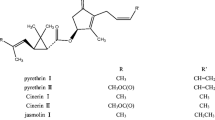Abstract
The dissipation and residue of the insecticide spinosad in zucchini were investigated. An ultra-performance liquid chromatography–tandem mass spectrometry analytical method was developed for spinosad analysis. The half-lives of spinosad were 3.5–3.9 days in zucchini and 3.6–4.1 days in soil. The results showed that the dissipation rate of spinosad was fast, and it is suggested that a combination of rapid growth of zucchini, photodecomposition and the activity of soil microorganisms affected the dissipation rate of spinosad. The terminal residues of spinosad in zucchini were all below the quantification limit. No residue limit currently exists for spinosad in zucchini in China and other countries. Thus, the results can be useful in establishing a maximum residue limit.



Similar content being viewed by others
References
Beigel C, Charnay MP, Barriuso E (1999) Degradation of formulated and unformulated triticonazole fungicide in soil: effect of application rate. Soil Biol Biochem 31:525–534
Bhadriraju S, Michelle H, Dhana RB (2012) Performance of pre-commercial release formulations of spinosad against five stored-product insect species on four stored commodities. Pest Sci 85:331–339
Chen ZL, Yang GS, Wang WB, Du HX, Ding RY, Chen Q, Mao JS (2006a) Determination of spinosyns and its metabolites in cotton plant. Chem Anal Meterage 15(6):45–47
Chen JM, Zuo JH, Yu XP, Zheng XS, Chen LZ, Zhang YF (2006b) Advances in toxicological research of newly-typed microbiological insecticide spinosad. Acta Agriculturae Zhejiangensis 18(5):401–406
Cleveland CB, Bormett GA, Saunders DG, Powers FL, McGibbon AS, Reeves GL, Rutherford L, Balcer JL (2002) Environmental fate of spinosad. 1. Dissipation and degradation in aqueous systems. Agric Food Chem 50:3244–3256
Du ST, Zhu MJ, Liang SZ (2005) Research progress on the biopesticide spinosad. Agrochemicals 44(10):441–444
Leeuwen TV, Dermauw W, Veire MV, Tirry L (2005) Systemic use of spinosad to control the two-spotted spider mite (Acari:Tetranychidae) on tomatoes grown in rockwool. Exp Appl Acarol 37:93–105
Li ZM, Wang WL, Wu HM, Liu SS, Liu YQ, Tang ZH (2006) Detection and analysis of spinosad in the body fluid of Cotesia plutellae larvae with HPLC. Acta Entomol Sinica 49(1):137–141
Sun N, Zhao CY, Liu H, Ma YN, Chen MX (2010) Determination of spinosad in vegetables by PSA dispersive solid phase extraction and high performance liquid chromatography-mass spectrometry. Chin J Anal Lab 29(8):70–74
Thompson GD, Dutton R, Sparks TC (2009) Spinosad-a case study: an example from a natural products discovery program. Pest Manage Sci 56:696–702
Wafa H, Hanene B, Yasmine A, Mohamed LO, Jean-pierre F, Claude E (2009) Spinosad affects chemical communication in the German cockroach, Blatella germanica(L). J Chem Ecol 35:1423–1426
Wang JJ, Lv JH (2012) Research and application progress on spinosad for controlling the stored grain insects. Cereal Feed Ind 4:19–22
Wang D, Ren XX, Zhang XF (2009) Research progress on resistance and its mechanism of spinosad. World Pestic 31(4):7–10
Wu CX, Nie G, Wang GC, Zhang ZM, Chen BK, Gao LM (2006) Determination of spinosad residues in water by HPLC. Agrochemicals 45(3):191–193
Zhan J, Yang LZ, Lin LY, Chen LP, Zhou L, Xu DM (2011) Determination of spinosyns A and D residues in food by high performance liquid chromatography tandem mass spectrometry. Chin J Chromatogr 29(7):637–642
Acknowledgments
This work was supported by grants from the Institute for Ministry of Agriculture of the People’s Republic of China.
Author information
Authors and Affiliations
Corresponding author
Rights and permissions
About this article
Cite this article
Liu, Y., Sun, H. & Wang, S. Dissipation and Residue of Spinosad in Zucchini Under Field Conditions. Bull Environ Contam Toxicol 91, 256–259 (2013). https://doi.org/10.1007/s00128-013-1050-3
Received:
Accepted:
Published:
Issue Date:
DOI: https://doi.org/10.1007/s00128-013-1050-3




